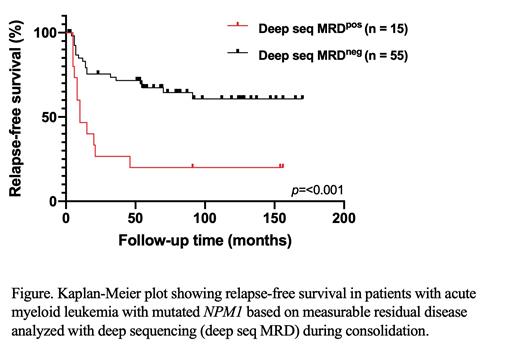Analysis of measurable residual disease (MRD) is a powerful tool for assessment of treatment response in acute myeloid leukemia (AML). In patients with mutation in NPM1, reverse transcription quantitative polymerase chain reaction (RT-qPCR) is recommended by European Leukemia Net for refinement of risk stratification and monitoring after treatment. However, since RT-qPCR is mutation-specific and requires stringent quality control, many clinical laboratories restrict NPM1 monitoring to the type A mutation (c.860_863dupTCTG) although >50 mutations have been reported in exon 12. Deep sequencing is an alternative method, performed on DNA, that covers all NPM1 exon 12variants in the same assay. Guidelines for its clinical use are however lacking. We here performed a retrospective analysis in a population-based cohort of AML patients to evaluate if deep sequencing MRD analysis of NPM1 during chemotherapy provides prognostic information.
Adult patients with AML with mutated NPM1 treated with curative intent in our region during 2006-2016 who achieved complete remission (CR) or CR with incomplete count recovery (CRi) were eligible for the study. This time period was chosen to avoid inclusion of patients treated based on molecular MRD status. Through review of the national AML registry, clinical charts, and screening of diagnostic samples, 99 patients with mutated NPM1 were identified. Of these, 97 patients (60 women and 37 men, median age 64 years, range 19-82) had bone marrow slides for isolation of DNA from at least one time point during treatment. DNA from 257 bone marrow aspirate slides were assessed for MRD using deep sequencing of NPM1. Based on previous comparison with RT-qPCR (Pettersson et al, Int J Lab Hematol 2021;43:664-674), variant allele frequency (VAF) of ≥0.05% was chosen as cut-off to define deep sequencing MRD positivity (MRD pos). For subgroup analyses, patients were divided into groups of treatment intensity; high-dose (cytarabine- and daunorubicin-based, n=67) or low-dose (cytarabine- and daunorubicin-, or azacytidine-based, n=30) treatment regimens. Thirty-one patients underwent allogeneic stem cell transplantation (alloSCT).
We first evaluated if deep sequencing MRD status during consolidation (n=70, analyzed after 2 or 3 cycles) had an impact on prognosis. Both 3-year relapse-free survival (RFS) (26.7±11.4% vs 71.6±6.2%, p=<0.001, Figure) and overall survival (OS) (33.3±12.2% vs 72.7±6%, p=0.004) were lower for patients that were MRD pos at any time point during consolidation than for MRD neg patients. Among MRD pos patients, 12/15 (80%) relapsed and 13/15 (87%) died, compared to 19/55 (35%) and 23/55 (42%) MRD neg patients. In univariate analyses, also age and treatment intensity, but not alloSCT or DNMT3A mutation status, predicted RFS and OS. FLT3-ITD predicted OS but not RFS, and there was no effect of FLT3-ITD allelic ratio. In Cox regression multivariate analysis including MRD, age, FLT3-ITD and treatment intensity, MRD pos was the only significant predictor of RFS (Hazard ratio (HR): 2.54, p=0.019). In the multivariate analysis, FLT3-ITD (HR: 2.43, p=0.014) and treatment intensity (HR: 0.43, p=0.035) were significant for OS (MRD pos HR: 1.75, p=0.13). When dividing the cohort based on treatment intensity, the effect of MRD status was most obvious in patients treated with low-dose regimens. When deep sequencing MRD analysis was performed post first cycle (n=96), it had no statistically significant effect on either RFS or OS. At the end of treatment (n=51), deep sequencing MRD status had a strong prognostic value with 3-year RFS and OS for MRD pos patients 30±14.5% and 40±15.5%, compared to 73.2±6.9% and 78±6.5% for MRD neg patients ( p=0.003 and p=0.006, respectively).
In summary, this population-based study shows that MRD status by deep sequencing of NPM1 is predictive of both RFS and OS when assessed during or after consolidation. The study confirms the threshold of deep sequencing MRD pos of VAF 0.05% previously obtained by comparison with RT-qPCR. Since deep sequencing can be used for all NPM1 mutations, it is widely applicable and extends the use of molecular MRD analysis and risk refinement to patients with rare mutations in NPM1.
Disclosures
No relevant conflicts of interest to declare.


This feature is available to Subscribers Only
Sign In or Create an Account Close Modal